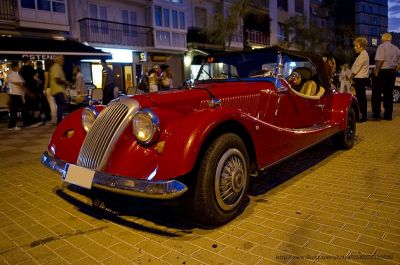 1969 Porsche 914 Dimensions, Size & Specs
1969 Porsche 914 Dimensions, Size & Specs
Measurements of the 1969 Porsche 914, engineered for optimal performance and comfort
| Dimensions | |
|---|---|
| Length: | 3985-4114 mm156.9-162.0 in13.1-13.5 ft |
| Width: | 1592-1650 mm62.7-65.0 in5.2-5.4 ft |
| Height: | 1220-1230 mm48.0-48.4 in4.0-4.0 ft |
| Ground Clearance: | 128-130 mm5.0-5.1 in0.4-0.4 ft |
| Trunk Capacity: | 160 liter5.7 cu ft |
| Trunk Capacity (Max): | 370 liter13.1 cu ft |
| Weight Specifications | |
| Curb Weight: | 898-1000 kg1980-2205 lbs |
| Maximal permitted Weight: | 1220-1260 kg2690-2778 lbs |
| Tire Specifications | |
| Rims Sizes: | 15-inch rims:
|
| Tire Size: |
|
The Porsche 914, produced between 1969 and 1976, stands out as a distinctive compact cabriolet sports car from the German manufacturer Porsche. Its design combines agility with a low-profile stance, making it a popular choice among enthusiasts of classic convertibles. The 914 measures in length between 3985 mm and 4114 mm (157 to 162 inches), with a width ranging from 1592 mm to 1650 mm (62.6 to 65 inches), and a height between 1220 mm and 1230 mm (48.0 to 48.4 inches). This compact footprint contributes to its nimble handling and sporty character.
In terms of weight, the Porsche 914 has a curb weight between 898 kg and 1000 kg (1,980 to 2,205 lbs), making it relatively lightweight for its era and size. The maximum weight allowed ranges from 1220 kg to 1260 kg (2,690 to 2,778 lbs), indicating solid build quality balanced with performance. Its ground clearance or ride height sits between 128 mm and 130 mm (5 to 5.1 inches), providing a low center of gravity that enhances driving dynamics.
The 914's luggage capacity is practical for a sports car of its class, offering 160 liters (5.7 cubic feet) under normal conditions and expanding to 370 liters (13 cubic feet) when the rear seats are folded down, allowing for increased cargo space. This makes it versatile enough for weekend trips or daily use despite its sporty profile.
Wheel and tire sizes complement the car's dimensions well, with available rims in sizes 5.5J x 15 and 4.5J x 15 paired with 155 R15 tires. These specifications ensure appropriate grip and ride comfort for the era, while maintaining the 914's distinctive look.
Overall, the Porsche 914 (1969-1976) represents a balance between classic design, efficient use of space, and spirited driving experience, making it a significant model to compare when assessing cabriolet sizes and vintage sports cars from the late 1960s to the mid-1970s.
Discover the standout features that make the 1969 Porsche 914 a leader in its class
Have a question? Please check our knowledgebase first.
The Porsche 914 from 1969 to 1976 comes in a length range between 3985 mm and 4114 mm (approximately 157 to 162 inches). This length variation depends on specific model configurations and production year adjustments. Given its relatively compact size, this makes the 914 easier to handle and maneuver compared to larger sports cars. Its moderate length enables more responsive driving dynamics and tighter turning radii, which is beneficial in urban environments or narrow roads. However, compared to modern vehicles, it might feel slightly longer due to its classic sports car proportions.
The Porsche 914's width ranges from 1592 mm to 1650 mm (approximately 62.6 to 65 inches), providing a relatively narrow profile by today's standards. This narrow width contributes to the car’s agility and sporty suspension setup, making cornering and weaving through traffic more intuitive and precise. Despite the compact width, the cabin offers reasonable comfort for two occupants, maintaining an open and classic sports car feel. The narrower stance also results in less wind resistance and a balance between interior space and vehicle performance.
The Porsche 914 stands at a height ranging from 1220 mm to 1230 mm (about 48 to 48.4 inches), making it a very low-profile sports car. This low stance significantly enhances handling by lowering the center of gravity, promoting better aerodynamics and stability at high speeds and during cornering. The downside, however, might include reduced visibility due to the low seating position and slim window openings. Additionally, the low height requires careful approach angles when navigating steep driveways or speed bumps, but it undeniably adds to the classic sports car appeal and driving engagement.
The curb weight of the Porsche 914 varies between 898 kg and 1000 kg (approximately 1980 to 2205 lbs). This lightweight construction, especially for its time, contributes to the 914’s nimble handling and quick acceleration. A lower weight improves several performance metrics, including braking distances, corner exit speeds, and overall agility. Weight also positively impacts fuel efficiency, making the 914 relatively economical compared to heavier sports cars. The use of lightweight materials and a mid-engine layout contributed to this balanced weight, enhancing both driving dynamics and efficiency.
The maximum weight capacity (gross vehicle weight) for the Porsche 914 ranges from 1220 kg to 1260 kg (2690 to 2775 lbs). This figure includes the vehicle’s curb weight plus passengers, cargo, and additional equipment. Considering its small two-seater design and limited cargo space, the car comfortably accommodates two occupants and modest luggage without nearing this limit. Overloading beyond this weight could negatively affect handling, braking, and suspension performance. For optimal safety and performance, it’s best to stay within the specified limits, especially during spirited driving or long-distance trips.
The Porsche 914 offers a luggage capacity of 160 liters (about 5.6 cubic feet) in its normal configuration, which can be increased to 370 liters (approximately 13 cubic feet) when rear seats are folded down. For a classic sports car with a mid-engine layout, this is a relatively practical cargo space, allowing drivers to carry basic luggage, grocery bags, or small sports equipment. The folding rear seats provide added versatility, making the 914 suitable for weekend trips or errands where extra space is needed. However, it’s important to note the compartment sizes are still limited compared to modern cars.
The Porsche 914 has a ground clearance ranging between 128 mm and 130 mm (approximately 5 to 5.1 inches). While this low clearance contributes to stable handling and improved aerodynamics, it requires cautious navigation over speed bumps, ramps, or uneven surfaces. Concerning garage fitment, the 914 is compact in height (1220-1230 mm or 48-48.4 inches) and width, so it comfortably fits into standard residential garages, which typically have a minimum clearance of around 2100 mm (82.7 inches) in height. Hence, owners shouldn’t face issues parking the Porsche 914 in most typical garages.
The Porsche 914 was a unique collaborative design between Porsche and Volkswagen, with no direct predecessor but follows Porsche's tradition of lightweight sports cars. Compared to the earlier Porsche 912, the 914 adopted a mid-engine layout, which shifted the weight distribution for improved handling. In terms of dimensions, the 914 was generally shorter, slightly narrower, and notably lighter than many contemporary models, weighing between 898 and 1000 kg. Its lower curb weight and balanced chassis offered enhanced driving dynamics. Improvements included better safety features, more modern styling, and greater practicality due to the mid-engine's impact on cargo space.
The Porsche 914 stood out in its era for its mid-engine layout, balanced performance, and compact size. Compared to contemporaries like the Alfa Romeo Spider and Triumph TR6, the 914 was more compact in both length (3985-4114 mm) and width (1592-1650 mm), with a lower curb weight (898-1000 kg). This resulted in lighter handling and more responsive dynamics. Performance-wise, the 914 was not the most powerful but excelled in balanced road manners and agility. Its relatively small luggage capacity contrasted with some competitors but was acceptable given its sports car classification. Overall, it offered a unique blend of driving purity and everyday function uncommon for the period.
The Porsche 914 was originally equipped with rim sizes of 5.5J x 15 at the front and 4.5J x 15 at the rear, paired with tire sizes of 155 R15. These relatively narrow tires by modern standards helped maintain a firm, connected feel with the road, emphasizing handling and driver feedback. The moderate rim size and sidewall height contribute to a balance of sporty handling while preserving ride comfort on typical road surfaces. The modest tire width also ensured that the car remained nimble, especially given its light weight and mid-engine configuration, which together provided excellent driving dynamics for a classic roadster.
Discover similar sized cars.

| Model Year: | 1997 |
|---|---|
| Length: | 4100 mm161.4 in |
| Width: | 1625 mm64.0 in |
| Height: | 1300 mm51.2 in |

| Production: | 2004-present |
|---|---|
| Model Year: | 2004 |
| Length: | 4100 mm161.4 in |
| Width: | 1625 mm64.0 in |
| Height: | 1300 mm51.2 in |

| Production: | 2008-present |
|---|---|
| Model Year: | 2008 |
| Length: | 4100 mm161.4 in |
| Width: | 1625 mm64.0 in |
| Height: | 1300 mm51.2 in |
